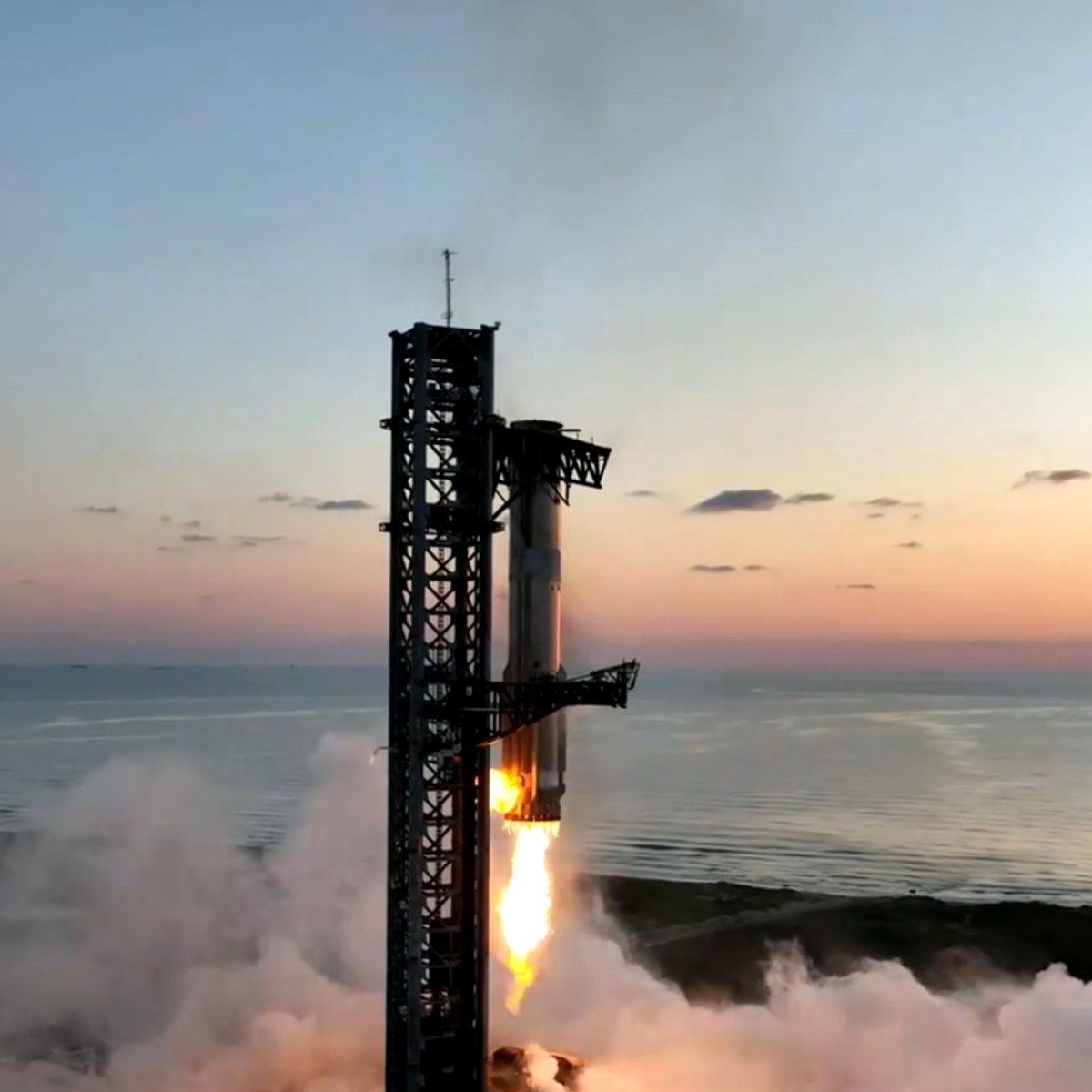SpaceX launched its fifth Starship vehicle Oct. 13, successfully making an unprecedented “catch” of its Super Heavy booster back at the launch site.
The Starship/Super Heavy vehicle lifted off from the company’s Starbase site at Boca Chica, Texas, at 8:25 a.m. Eastern on a mission called Flight 5 by SpaceX.
The main upgrade for this test was an attempt by SpaceX to recover the Super Heavy booster by having it come back to the launch site, where it would be cradled by two mechanical arms, sometimes called “chopsticks,” attached to the launch tower it lifted off from. That required the booster to perform precise boostback and landing burns to guide the stage back to the launch pad.
The Super Heavy booster, known as Booster 12, achieved that feat. The booster descended over the pad and the two arms closed around the top of the booster, just below the grid fins, about seven minutes after liftoff, achieving the desired catch of the booster.
It was amazing to watch, the engines glowing on reentry was insane!
The engines glowing made me reeeeeal nervous
I was waiting for the overheat indicators to pop up
It was crazy to see the engines glowing but the nozzles cool, such an unexpected scene!
Was that atmospheric heating from the re-entry?
Purely from compression, not from friction. Honestly, I’m curious how they guard against backflow in the nozzles. A tesla valve would be cool, but I also have no idea how those perform in ultra-high-pressure/flow scenarios
Exactly. The everyday astronaut footage shows it particularly vividly.
Amazing! What is left to do now? Orbital Raptor relight and dummy payload deployment? Do they need a new launch license for that, or is the current one (which should be good for similar flights if I understand correctly) sufficient? S31 + B13?
I assume they will want to demonstrate the V2 flap design before attempting a ship catch. They also need the second tower for that, unless the booster can be destacked sufficiently fast.
S31 + B13?
Is there a possibility that they might skip the last two V1 Starships and jump straight to S33?
They also need the second tower for that, unless the booster can be destacked sufficiently fast.
For a ship catch, they could potentially leave the ship in a coast phase for multiple orbits while they safe and destack the booster.
Is there a benefit to catching the booster instead of having it land? Was this one extra tall? Sorry in advance if these are dumb questions.
There’s two main benefits: faster reuse and more payload to orbit.
A Falcon 9 landing on a drone ship needs to be transported back to shore. That’s multiple days before the engineers even get their hands on it to prepare for the next flight. The design goal of Starship is to launch a Ship into orbit, return to the tower, be restacked, refuelled and launched again in the same day. Will they actually get it to the point where that’s possible? Remains to be seen. Until now, they had no way to see what real stresses a Starship booster goes through in a flight. They’re gonna rip this one apart down to the spacers in its bolts to examine it. With the flight and physical inspection data, they’ll make what improvements they can to the already built boosters and design future boosters to be more resilient. SpaceX has, by now, a well proven track record of doing what others think is insane to even attempt. If anyone can launch the same rocket twice in a day, there’s no one better to give it a try.
The increased payload comes from not having the mass of the landing legs. The Falcon’s landing legs weigh several tons. Starship, being 3x the diameter and 10x the mass, would need titanic landing legs. That’s a lot of tonnage you won’t be taking to orbit. Catching on the tower means that all but a fraction of the landing hardware’s mass isn’t on the rocket itself. As an additional benefit, the landing hardware needs to be built only once. Every Falcon has its own landing legs, but every Starship they ever build could land on the one tower they have now. That won’t be the case, they’re planning to build multiple towers, but the sentiment remains the same.
Not to mention the landing legs being single use - they have to replace them each landing.
Do they replace the entire legs between flights, or just the crush core?
It was just the crush core iirc but that required servicing the entire leg.
Hopefully it means a reduced mass since the booster doesn’t need any landing legs which means more performance. The idea is that boosters should be quickly reusable, basically landing and being refueled before flying again. That would take more time with a separate landing location
Those landing-legs that would be required add a lot of extra weight and in case of the Falcon 9 are a common mode of failure.





